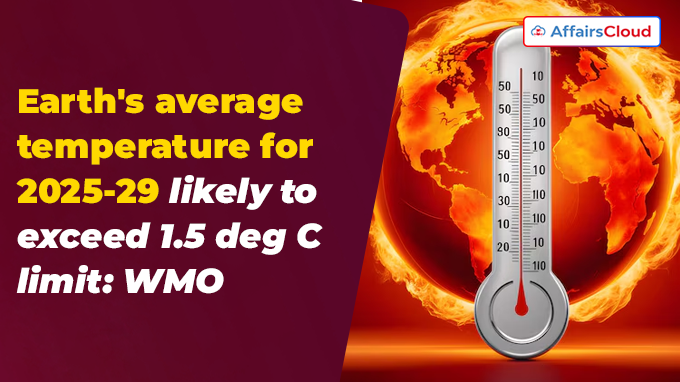 On May 28, 2025, the Geneva (Switzerland) based World Meteorological Organization (WMO) released its ‘Global Annual to Decadal Climate Update (2025–2029)’, projecting a significant likelihood of global temperatures temporarily surpassing the 1.5 degree Celsius (°C) threshold above pre-industrial levels (1850–1900) within the next five years.
On May 28, 2025, the Geneva (Switzerland) based World Meteorological Organization (WMO) released its ‘Global Annual to Decadal Climate Update (2025–2029)’, projecting a significant likelihood of global temperatures temporarily surpassing the 1.5 degree Celsius (°C) threshold above pre-industrial levels (1850–1900) within the next five years.
- This projection underscores the escalating urgency for comprehensive climate action to mitigate the adverse effects of global warming.
Key Projections:
i.Annual Temperature Increase: Each year from 2025 to 2029 is expected to witness an average global near-surface temperature rise between 1.2°C and 1.9°C above the 1850–1900 baseline.
ii.Record-Breaking Years: There is an 80% chance that at least one year in 2025 to 2029 will surpass 2024 as the warmest year on record.
iii.Exceeding Paris Agreement Threshold: An 86% probability exists that at least one year during 2025 to 2029 will exceed 1.5°C above pre-industrial levels, a critical threshold outlined in the 2015 Paris Agreement.
iv.Five-Year Average: The report indicates a 70% chance that the five-year average warming for 2025–2029 will be more than 1.5°C above the pre-industrial average, up from 47% in the previous year’s report.
Regional Climate Impacts:
1.Arctic Region
i.Accelerated Warming: The Arctic is anticipated to warm over 3.5 times faster than the global average, with temperatures rising by 2.4°C above the 1991–2020 baseline during the November to March periods.
ii.Sea Ice Decline: Further reductions in sea-ice concentration are expected in the Barents Sea, Bering Sea, and Sea of Okhotsk by March 2025-2029.
2.South Asia
i.Increased Rainfall: The WMO forecasts that South Asia will continue to experience wetter-than-average conditions between 2025 and 2029, extending the trend observed in recent years, except for 2023.
ii.India’s Monsoon Outlook: The New Delhi (Delhi) based India Meteorological Department (IMD) is expected to continue experiencing above-average monsoon rainfall through 2029, extending the trend observed in recent years, excluding 2023.
3.Others:
i.Wetter Conditions: Predicted precipitation patterns for May–September 2025–2029 suggest wetter-than-average conditions in the Sahel, Northern Europe, Alaska, and Northern Siberia.
ii.Drier Conditions: Conversely, the Amazon region is expected to experience drier-than-average conditions during the same period.
Long-Term Warming Context:
i.The Paris Agreement aims to limit long-term global warming to 1.5°C above pre-industrial levels, measured over 20–30 years, not just in a single year.
ii.2024 was the first calendar year to breach 1.5°C (reaching 1.55 ± 0.13°C), marking the 10th consecutive warmest year on record (WMO State of the Global Climate 2024 report).
iii.The current central estimate for the 20-year average warming (2015–2034) is 1.44°C, with a 90% confidence range of 1.22°C to 1.54°C.
Global Implications:
i.Extreme Weather Events: The anticipated temperature rise is likely to intensify heatwaves, extreme rainfall events, and droughts globally
ii.Cryosphere Impact: Melting of ice sheets, sea ice, and glaciers is expected to accelerate, contributing to sea-level rise.
iii.Oceanic Changes: Increased ocean heating may lead to more frequent and severe marine heatwaves, affecting marine ecosystems and fisheries.
Policy Urgency:
195 countries under the United Nations Framework Convention on Climate Change (UNFCCC) must submit Nationally Determined Contributions (NDCs) for 2031–2035 period ahead of the 30th Conference of the Parties (COP30), scheduled to be held in 2025 in Belém, Brazil from November 10-21, 2025.
- Only 15 of 195 UNFCCC parties have submitted NDCs so far, highlighting a critical gap in climate action.
- COP30 will review these climate plans, which are vital to limit long-term warming to 1.5°C.
About World Meteorological Organization (WMO):
Secretary General – Celeste Saulo
Headquarters – Geneva (Switzerland)
Established – 1950




